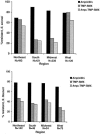High prevalence of antimicrobial resistance among Shigella isolates in the United States tested by the National Antimicrobial Resistance Monitoring System from 1999 to 2002
- PMID: 16377666
- PMCID: PMC1346809
- DOI: 10.1128/AAC.50.1.49-54.2006
High prevalence of antimicrobial resistance among Shigella isolates in the United States tested by the National Antimicrobial Resistance Monitoring System from 1999 to 2002
Abstract
Shigella spp. infect approximately 450,000 persons annually in the United States, resulting in over 6,000 hospitalizations. Since 1999, the National Antimicrobial Resistance Monitoring System (NARMS) for Enteric Bacteria has tested every 10th Shigella isolate from 16 state or local public health laboratories for susceptibility to 15 antimicrobial agents. From 1999 to 2002, NARMS tested 1,604 isolates. Among 1,598 isolates identified to species level, 1,278 (80%) were Shigella sonnei, 295 (18%) were Shigella flexneri, 18 (1%) were Shigella boydii, and 7 (0.4%) were Shigella dysenteriae. Overall, 1,251 (78%) were resistant to ampicillin and 744 (46%) were resistant to trimethoprim-sulfamethoxazole (TMP-SMX). Prevalence of TMP-SMX- or ampicillin- and TMP-SMX-resistant Shigella sonnei isolates varied by geographic region, with lower rates in the South and Midwest regions (TMP-SMX resistance, 27% and 30%, respectively; ampicillin and TMP-SMX resistance, 25% and 22%, respectively) and higher rates in the East and West regions (TMP-SMX resistance, 66% and 80%, respectively; ampicillin and TMP-SMX resistance, 54% and 65%, respectively). Nineteen isolates (1%) were resistant to nalidixic acid (1% of S. sonnei and 2% of S. flexneri isolates); 12 (63%) of these isolates had decreased susceptibility to ciprofloxacin. One S. flexneri isolate was resistant to ciprofloxacin. All isolates were susceptible to ceftriaxone. Since 1986, resistance to ampicillin and TMP-SMX has dramatically increased. Shigella isolates in the United States remain susceptible to ciprofloxacin and ceftriaxone.
Figures
References
-
- Acikgoz, Z. C., Z. Gulay, M. Bicmen, S. Gocer, and S. Gamberzade. 2003. CTX-M-3 extended-spectrum beta-lactamase in a Shigella sonnei clinical isolate: first report from Turkey. Scand. J. Infect. Dis. 35:503-505. - PubMed
-
- Ambler, J. E., Y. J. Drabu, P. H. Blakemore, and R. J. Pinney. 1993. Mutator plasmid in a nalidixic acid-resistant strain of Shigella dysenteriae type 1. J. Antimicrob. Chemother. 31:831-839. - PubMed
-
- American Academy of Pediatrics. 2000. Shigella infections, p. 510-512, 645. In L. Pickering (ed.), 2000 Red book: report of the Committee on Infectious Diseases, 25th ed. American Academy of Pediatrics, Elk Grove Village, Ill.
-
- Ashraf, M. M., Z. U. Ahmed, and D. A. Sack. 1991. Unusual association of a plasmid with nalidixic acid resistance in an epidemic strain of Shigella dysenteriae type 1 from Asia. Can. J. Microbiol. 37:59-63. - PubMed
Publication types
MeSH terms
Substances
LinkOut - more resources
Full Text Sources
Medical
Miscellaneous


